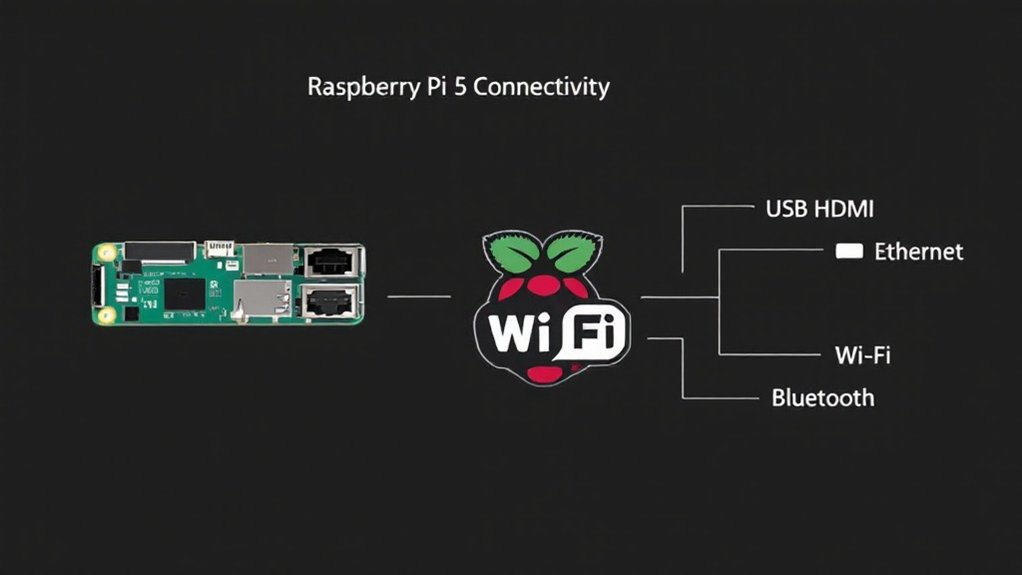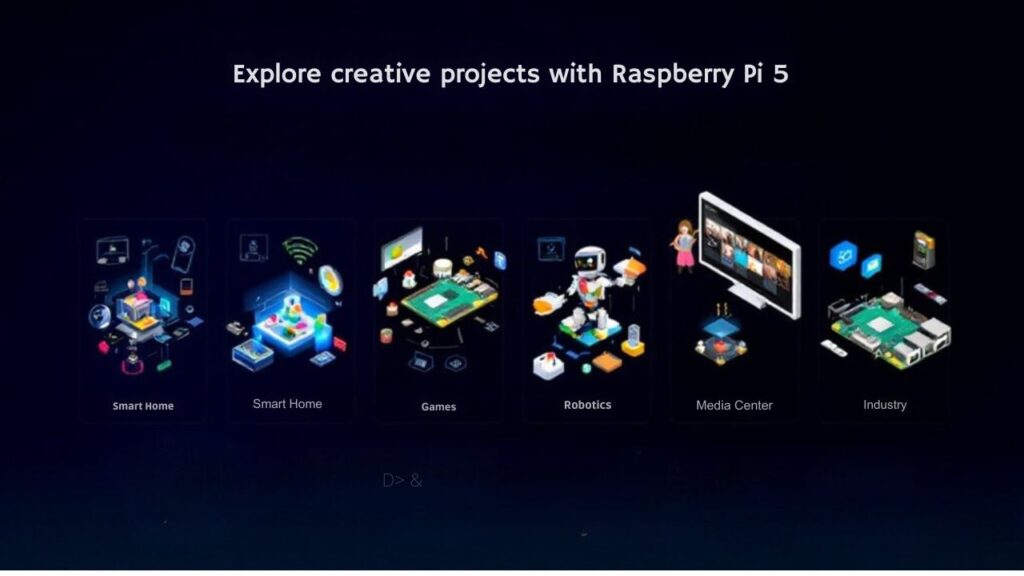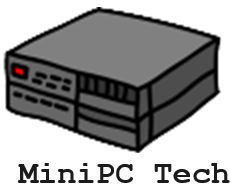The Raspberry Pi 5 revolutionizes single-board computing with its impressive 2.4GHz quad-core CPU and high-memory options of up to 8GB. You’ll love the dual 4K output for stunning visuals, and its efficient cooling system guarantees peak performance during demanding tasks. With robust connectivity options like gigabit Ethernet and Wi-Fi, it seamlessly integrates into any setup. Whether you’re using it for media streaming, IoT projects, or even desktop computing, the Pi 5 excels in versatility. Ready to explore what this powerhouse can do for your projects? You’ll discover even more exciting features just around the corner.
Key Takeaways
- The Raspberry Pi 5 features a powerful 2.4GHz quad-core CPU, delivering a significant performance boost in single-core and multi-threading tasks compared to its predecessor.
- Equipped with dual 4Kp60 HDMI output, it excels in high-resolution media playback, making it perfect for home entertainment and digital signage.
- Connectivity options include 1Gbit Ethernet, Wi-Fi, and Bluetooth, ensuring seamless integration with devices and efficient IoT applications.
- Its efficient cooling system and power management enable it to maintain optimal performance while consuming minimal energy, ideal for various environments.
- Versatile in applications, the Raspberry Pi 5 serves as a desktop computer, media center, gaming device, and learning tool for programming and electronics.
Hardware Specifications Overview
When you plunge into the hardware specifications of the Raspberry Pi 5, you’ll find a powerful and efficient computing platform designed for a variety of applications.
At its heart, the Pi 5 boasts a 2.4GHz quad-core 64-bit Arm Cortex-A76 CPU paired with generous cache memory: 512KB per-core L2 caches and a shared 2MB L3 cache. This impressive setup guarantees snappy performance for multitasking and computational tasks while cryptography extensions enhance its security capabilities. The Raspberry Pi 5 also offers a significant performance increase, with a 2.4x improvement in single-core tasks compared to the Raspberry Pi 4.
For memory options, you can choose between 4GB or 8GB of LPDDR4X-4267 SDRAM, catering to diverse project needs. The micro SD card slot, supporting high-speed SDR104 mode, allows for significant storage expansions up to 2TB. Plus, the option for an M.2 NVMe SSD via M.2 HAT pushes the limits of storage speed. Furthermore, the Raspberry Pi 5 benefits from dual-band 802.11ac Wi-Fi, ensuring robust and fast wireless connectivity for various applications. Additionally, the Raspberry Pi 5 supports multiple RAM options, including a model with 2GB, offering flexibility for different computing demands.
The Raspberry Pi 5’s hardware capabilities are impressive, enabling dual 4Kp60 HDMI output and a robust VideoCore VII GPU, paving the way for high-resolution graphics applications such as home media centers or gaming, which are common use cases for this model.
With a well-rounded mix of performance and versatility, it’s clear that the Raspberry Pi 5 is designed for innovators enthusiastic to explore its full potential.
Connectivity Options

The Raspberry Pi 5 offers a variety of connectivity options that enhance its functionality and expandability for diverse applications. With a solid 1Gbit Ethernet port, you can expect reliable performance straight out of the box.
While it may not match competitors like the Radxa ROCK 5B in speed, you still benefit from Ethernet advantages like stable connections and true real-world throughput. To further enhance your network capabilities, consider these options:
- USB Ethernet Adapter: Access higher speeds up to 2.5Gbps.
- PCIe Expansion: Add more Ethernet ports or WiFi cards with additional lanes.
- HAT Compatibility: Utilize HATs for further customization.
WiFi, while improved with the Infineon CYW43455 chip, has its limitations. You’ll enjoy faster speeds compared to the Pi 4, but the real-world performance peaks around 90-100 Mbps. Higher throughput is achievable when using upgraded USB3 Type-A ports, which reflect an advancement over previous models. Additionally, to unlock greater speeds, consider using higher Ethernet speed adaptors that offer enhanced performance options.
Plus, the signal strength drops after about 12 meters, which could hinder access point performance. To achieve higher speeds or better range, you’ll likely need external adapters. This setup can also benefit from wireless HDMI technology for transmitting high-definition audio and video signals without cables.
The Raspberry Pi 5’s connectivity options provide a balanced blend of flexibility and pragmatism, allowing for tailored solutions to suit your innovative projects. For users looking to repurpose their device as an IoT hub, the Raspberry Pi 5’s connectivity features are particularly advantageous.
The Raspberry Pi 5’s connectivity options provide a balanced blend of flexibility and pragmatism, allowing for tailored solutions to suit your innovative projects.
Performance Insights

Significant improvements in performance set the Raspberry Pi 5 apart from its predecessor, delivering faster processing and enhanced capabilities that cater to a variety of tasks. You’ll notice these advancements across various performance metrics including CPU speed, memory bandwidth, and real-world application efficiency. With the Pi 5 showcasing an impressive performance increase of ×2.4 in single-core tasks compared to the Pi 4, it enhances multi-threading and overall responsiveness in everyday applications. Additionally, the hardware specifications of the Pi 5, with its quad-core Cortex-A76 processor, contribute to its superior performance in handling complex processes.
Here’s a snapshot of benchmark comparisons:
| Metric | Raspberry Pi 5 | Raspberry Pi 4 |
|---|---|---|
| Single-thread Sysbench | 1041 MBps | 699 MBps |
| Multi-thread Sysbench | 4165 MBps | 2794 MBps |
| Geekbench 6 Single-Core | 764 + 774 | N/A |
With a quad-core Cortex-A76 processor reaching up to 2.4GHz, the Pi 5 boosts single-core scores by 2.4 times. Multi-threading showcases an even more impressive 49% increase; it can complete tasks 75-80% faster compared to the Pi 4. Real-world applications also reflect significant gains, doubling or tripling performance in areas like web app processing and image editing. Overall, the Raspberry Pi 5 stands as a powerhouse, equipped to handle demanding tasks with ease, making it an exciting choice for innovators and tech enthusiasts alike.
Power Efficiency and Cooling

Building on the impressive performance gains of the Raspberry Pi 5, power efficiency and cooling solutions play an essential role in maximizing its capabilities without compromising longevity.
This tiny powerhouse manages a standby consumption of just 1.3 Watts, though it can draw 7 Watts under stress. However, using effective power saving techniques, like changing the ‘POWER_OFF_ON_HALT’ setting, can cut shutdown consumption to an impressive 0.01W. Furthermore, configuring the device with specific HATs can influence standby current during power off.
To guarantee peak performance during demanding tasks, consider these thermal solutions:
- Active Cooling: The Raspberry Pi Active Cooler features an aluminum heatsink with a temperature-controlled blower fan, critical for preventing thermal throttling. The entire unit is constructed from anodised aluminium, ensuring durability and efficient heat dissipation.
- Temperature Management: Built-in firmware manages cooling, ramping up fan speed based on temperature to maintain performance while minimizing overheating.
- Idle Efficiency: At idle, the Pi 5’s temperature remains around 50.5°C with potential drops to 45°C post-load when using proper cooling strategies.
Real-World Usage Scenarios

With its versatility, the Raspberry Pi 5 can seamlessly fit into various real-world usage scenarios, making it a valuable tool for both hobbyists and professionals.
One practical use case is lightweight desktop computing. By running multiple applications thanks to its improved CPU and RAM, you can enjoy a cost-effective alternative to traditional laptops or tablets. This is particularly beneficial due to its low power consumption, making it suitable for continuous operation in harsh environments with fanless operation.
Another compelling application lies in kiosk solutions. The Pi 5 excels in creating cost-effective kiosk devices that support touchscreens and can run sophisticated kiosk-mode apps, making it perfect for businesses needing efficient solutions.
Its capability to support 4K displays opens doors for innovative customer experiences.
For those interested in IoT and rapid prototyping, the Raspberry Pi 5 serves as an exceptional platform. You can easily connect various devices, monitor them, and even act as a dedicated server with enhanced remote management options and robust connectivity features such as Ethernet, USB, HDMI, Wi-Fi, and Bluetooth.
Its enhanced I/O capabilities and robust connectivity options guarantee seamless integration.
Lastly, as a home entertainment hub, it can decode high-quality video while serving as a NAS device for central file storage.
These real-world applications showcase the Raspberry Pi 5’s adaptability, making it a vital asset in today’s tech-driven landscape.
Frequently Asked Questions
What Operating Systems Are Compatible With Raspberry Pi 5?
You’ve got several Raspberry Pi distributions to choose from, like Raspberry Pi OS featuring Wayland and Debian 12. Explore alternatives like Ubuntu and Armbian, each offering unique operating system features tailored to your innovative needs.
Can I Use Raspberry Pi 4 Accessories With Raspberry Pi 5?
You can’t just toss Raspberry Pi 4 accessories onto the Pi 5 like confetti; accessory compatibility isn’t guaranteed. Embrace innovation with dedicated accessories designed for Raspberry Pi upgrades to confirm peak performance and functionality.
Is Raspberry Pi 5 Suitable for Gaming Applications?
Yes, the Raspberry Pi 5 excels in gaming applications, boasting impressive performance benchmarks for gaming emulation. You’ll enjoy retro games smoothly, but high-end titles may challenge its limits, requiring external help for ideal play.
How Does Raspberry Pi 5 Compare to Other Single-Board Computers?
The Raspberry Pi’s like a racing car compared to other single-board alternatives, shattering performance benchmarks. With superior hardware specifications, it accelerates tasks, offering innovative experiences that far surpass what many competitors can achieve.
What Programming Languages Are Best for Raspberry Pi 5 Development?
For Raspberry Pi 5 development, you’ll find Python programming intuitive for beginners, C++ development grants flexibility, Java applications enhance cross-platform capabilities, while Scratch projects simplify learning. Consider Rust performance for efficient, systems-level programming too.
Conclusion
In the vibrant world of DIY projects, the Raspberry Pi 5 shines like a beacon of possibility. It blends impressive hardware specs with seamless connectivity, offering you tools to release your creativity. Picture yourself crafting a smart home hub or breathing life into retro gaming—it’s all at your fingertips. With its power efficiency and innovative cooling, you can dive deep into your projects without a hitch. The Raspberry Pi 5 isn’t just a gadget; it’s your canvas for exploration.

I am a retired software engineer with experience in a multitude of areas including managing AWS and VMWare development environments. I bought a relative a mini-PC a year ago and have become passionate about the technology and its potential to change how we deploy software.

